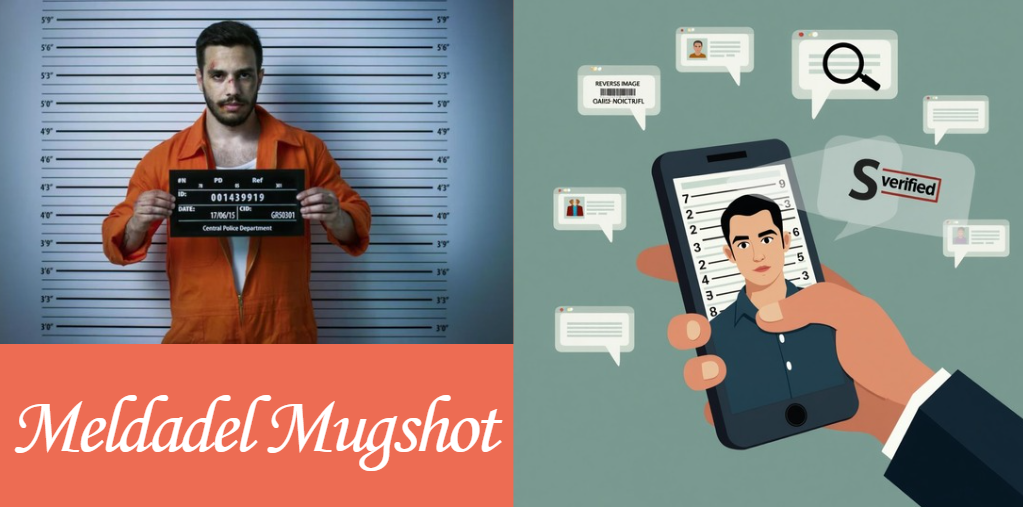The Viral Mystery of the Meldadel Mugshot: Internet Hoax or Hidden Truth?
In an age where digital misinformation spreads like wildfire, few cases highlight the strange mix of curiosity and confusion as clearly as the meldadel mugshot. This image, allegedly showing an unknown individual named Meldadel in a booking photo, has captured the internet’s attention—but not because of any verified arrest or crime.
In fact, there’s growing consensus that this might be nothing more than a fabricated visual born out of meme culture or viral manipulation.
This article explores every angle of the meldadel mugshot mystery: where it started, how it spread, what investigations reveal, and how to identify whether such content is real or fake. Let’s unpack the phenomenon in plain language, backed by research and actionable insights.
What Is the Meldadel Mugshot?
The meldadel mugshot refers to a photo that circulated on various social platforms in late 2023 and early 2024. It appears to show a woman in a typical booking-photo pose, often accompanied by vague or conflicting captions about her alleged arrest.
The name “Meldadel” appears either in the photo metadata or in text overlays, leading viewers to believe it is her identity.
However, a closer look reveals that there’s no official police report, arrest record, or media coverage confirming the existence of a person named Meldadel involved in any real-world legal case.
Origins and How It Went Viral
The first sightings of the meldadel mugshot came from TikTok and Reddit threads, where users speculated about the photo’s origin. Some said it was tied to a criminal charge in Los Angeles, while others claimed it was a case of mistaken identity. What made the photo viral wasn’t clarity—but its ambiguity.
Here’s a timeline of how the image went viral:
| Date | Platform | Event |
|---|---|---|
| Oct 2023 | TikTok | First post containing the image with the name “Meldadel” gains traction |
| Nov 2023 | Speculation thread in r/CrimeDiscussion links image to a supposed arrest | |
| Jan 2024 | Twitter/X | Meme accounts start sharing edited versions of the mugshot with humorous captions |
| Mar 2024 | Facebook Groups | Older demographic begins discussing the image as if it were news |
The key factor in the photo’s viral spread wasn’t authenticity, but the internet’s fascination with mysterious and sensational content.
Breaking Down the Image
Analyzing the image reveals a few telling inconsistencies:
- Lighting and resolution: Unlike official mugshots which are shot in controlled environments, this image has soft shadows and lighting effects suggestive of photo editing or staged photography.
- No source attribution: There’s no evidence of the image coming from a police department or official criminal database.
- Reverse image search: Tools like TinEye and Google Images show no credible results connecting this image to a real person or legal case.
In short, visual cues combined with metadata analysis strongly point to the image being fabricated or misused out of context.
No Official Records, No Real Arrest
Despite claims across blogs and forums, no law enforcement agency has confirmed an arrest under the name “Meldadel.” Searching public records—including Los Angeles County jail databases, federal court documents, and FOIA-based platforms—turns up zero results.
This raises the possibility that:
- “Meldadel” may be a fictional name.
- The image is digitally altered or AI-generated.
- The photo was originally from another context (e.g., a photoshoot or film still).
Either way, the lack of corroborating evidence makes it clear that the meldadel mugshot cannot be treated as a legitimate arrest photo.
Why Do Fake Mugshots Go Viral?
To understand the appeal of the meldadel mugshot, we need to explore the psychology behind viral hoaxes:
- Shock value: Audiences love scandal, especially when it seems hidden or “leaked.”
- Visual simplicity: A mugshot is instantly recognizable and feels “official,” even when fake.
- Lack of verification: Most people don’t fact-check memes before sharing.
Historically, similar fake mugshots have gone viral. For example, a heavily edited image of a celebrity in handcuffs circulated for weeks before being debunked. These hoaxes thrive in fast-moving digital spaces where curiosity outweighs skepticism.
How to Verify a Mugshot or Online Arrest Claim
You don’t have to be a journalist to verify whether an arrest photo is real. Here’s a toolkit to help:
Reverse Image Search Tools:
- Google Images
- TinEye
- Yandex
Metadata Analysis:
Use free tools like ExifTool or browser extensions to inspect image files for original dates, camera details, or software used.
Public Records Search:
Check databases such as:
- Los Angeles County Inmate Locator
- PACER for federal court cases
- FOIA.gov for requesting records
If the image doesn’t appear in official databases, treat it with caution.
Legal and Ethical Considerations
Publishing or spreading unverified mugshots is not just irresponsible—it can be legally risky.
Potential Consequences:
- Defamation: If “Meldadel” is a real person and wrongly linked to a crime, legal claims may follow.
- Invasion of privacy: Even if the photo is authentic, sharing it without context or consent may violate rights.
Countries like those in the EU have “Right to Be Forgotten” laws, while U.S. laws vary by state. Always prioritize accuracy and ethics before reposting questionable content.
Frequently Asked Questions
What are the most telling signs of an AI‑generated mugshot?
AI‑generated images often exhibit subtle inconsistencies: mismatched earrings or clothing patterns, uneven lighting across the face, blurred or duplicated background elements, and irregular reflections in the eyes. Examining these anomalies—especially around the hairline, ears, and background—can reveal deepfake artifacts that real booking‑photo setups would never produce.
Which fact‑checking organizations routinely debunk viral mugshot claims?
Several reputable outlets maintain dedicated fact‑check desks for image‑based hoaxes. Snopes, AFP Fact Check, PolitiFact, and Full Fact frequently publish in‑depth analyses of viral photos. They combine reverse‑image searches with expert interviews and primary‑source verification to confirm or refute a mugshot’s authenticity.
What legal precedents exist for pursuing creators of fake mugshot hoaxes?
Defamation lawsuits have been filed against individuals who publish fabricated arrest photos that damage reputations. In one notable case, a blogger was ordered to pay damages after posting a doctored celebrity mugshot as fact. Civil courts have increasingly recognized that knowingly spreading false arrest images can constitute libel, leading to financial penalties or injunctions.
How can educators use the Meldadel mugshot case in media‑literacy curricula?
Teachers can present the meldadel mugshot as a real‑world example of digital misinformation. Classroom activities might include guided reverse‑image searches, metadata‑analysis workshops, and debates on ethical reporting. By dissecting each step of the hoax’s spread, students learn critical thinking skills and the importance of source evaluation.
What psychological impacts can viral mugshot hoaxes have on individuals and communities?
Even unverified images can trigger fear, anxiety, or misplaced suspicion—particularly if viewers believe the subject poses a real threat. Communities may become distrustful of legitimate news, and innocent individuals who resemble the hoax subject can suffer reputational harm. Over time, repeated exposure to such scams erodes public trust in online information.
Conclusion
The story of the meldadel mugshot is a powerful reminder of how quickly misinformation can spread when left unchecked. While the photo may look convincing, deeper investigation reveals no evidence of a real person, arrest, or crime.
It’s likely the result of internet culture creating a hoax that feels real enough to share—but not real enough to verify.
If you encounter suspicious content online, take a moment to pause, verify, and question. In today’s digital world, critical thinking is the first line of defense against viral misinformation.
Read more
Unveiling ndrynk: A Revolutionary Fusion of Wellness Innovation and Musical Brilliance
Harness the Power of vhzptfhrm for Smarter Workflows and Well‑Being
Navigating the Future of Voice Technology with skylightvoice.com






